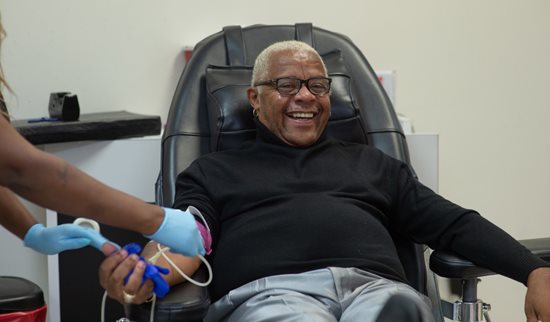It’s no secret that blood donations save lives — after all,1 in every 7 people entering a hospital needs blood. But you may be wondering: Is donating blood safe?
Of course it is! If you’re a healthy adult, you too can donate blood without endangering your health. Strict safety procedures and the use of sterile, single-use equipment ensure that blood donation carries no risk of contracting any blood-borne illness.
Still not convinced? Before every appointment, you even get a free mini-physical to ensure you are healthy enough to donate. One of our healthcare professionals checks your pulse, blood pressure, temperature and hemoglobin. People who successfully donate also have their cholesterol measured. As you can see, donating blood is safe, not to mention beneficial to you.
Vitalant’s donation centers and blood drives are also equipped with refreshment areas called canteens. When you’re finished, you can relax and recover your energy. Our friendly staff ask that you stay 15 minutes and enjoy a snack and drink to help replace lost fluids. Besides, who doesn’t love cookies?

But what then — how do we know your blood can be safely transfused to patients? After your donation, and to protect recipients, your blood gets tested for HIV, syphilis, and several types of hepatitis, among other infections. If your blood tests positive, it will not be given to a patient. This doesn’t happen very often, so don’t let that stop you from donating blood and saving lives!
Many people take for granted just how safe blood transfusion has become, but it wasn’t always this way. If you appreciate really cool blood donation facts and a good story, you've come to the right place.
Physicians from the olden days engaged in some truly questionable medical practices. To be fair, modern medicine has the benefit of hindsight, and we simply know more about blood and human anatomy today. Still, what may have been considered groundbreaking at the time is now seen as archaic, dangerous and even bizarre.
Everything from bloodletting and animal blood were once relied upon to cure fevers, pneumonia and even cancer. Things only get weirder from there. Did you know some phlebotomists were even transfusing patients with milk as late as the 19th century? Yes, you read that right; the same stuff you pour over your cereal. This unusual practice was particularly popular throughout North America to treat people stricken with tuberculosis.
While perhaps our predecessors deserve credit for some truly out-of-the-box thinking, by today’s standards, their methods were nothing short of medieval. But Rome wasn’t built in a day, and neither was the first blood bank. There were just too many unknowns.
Even the way blood circulated throughout the human body wasn’t understood until the early 1600s. But most problematic of all was blood’s pesky habit of sometimes sickening or killing recipients. (We can only imagine how frustrating this would have been for physicians of the time.) Although it was known to the scientific community that mixing blood from two people could result in red cells clumping together or exploding, they didn’t know why.
That all changed in 1901 when Karl Landsteiner, an Austrian immunologist and pathologist, cracked the case by proving there were different blood groups. This changed everything, quickly paving the way to safe blood transfusions between people with compatible blood groups.
While more extreme practices such as bloodletting are still occasionally used by hospitals today, (leeches, for example, can help reduce venous congestion and prevent tissue necrosis), rest assured your local donation center uses only the safest, most sophisticated technology and does not rely on predatory worms at any point throughout the process!
There’s a critical blood shortage, and patients need your help as soon as possible. Now that you know how safe blood donation is, schedule your appointment today.
Better yet, share everything you’ve learned with people you know and ask them to donate alongside you to double your impact. Learn more about blood donation.
Published by: Jeremy T. — Vitalant Contributor

